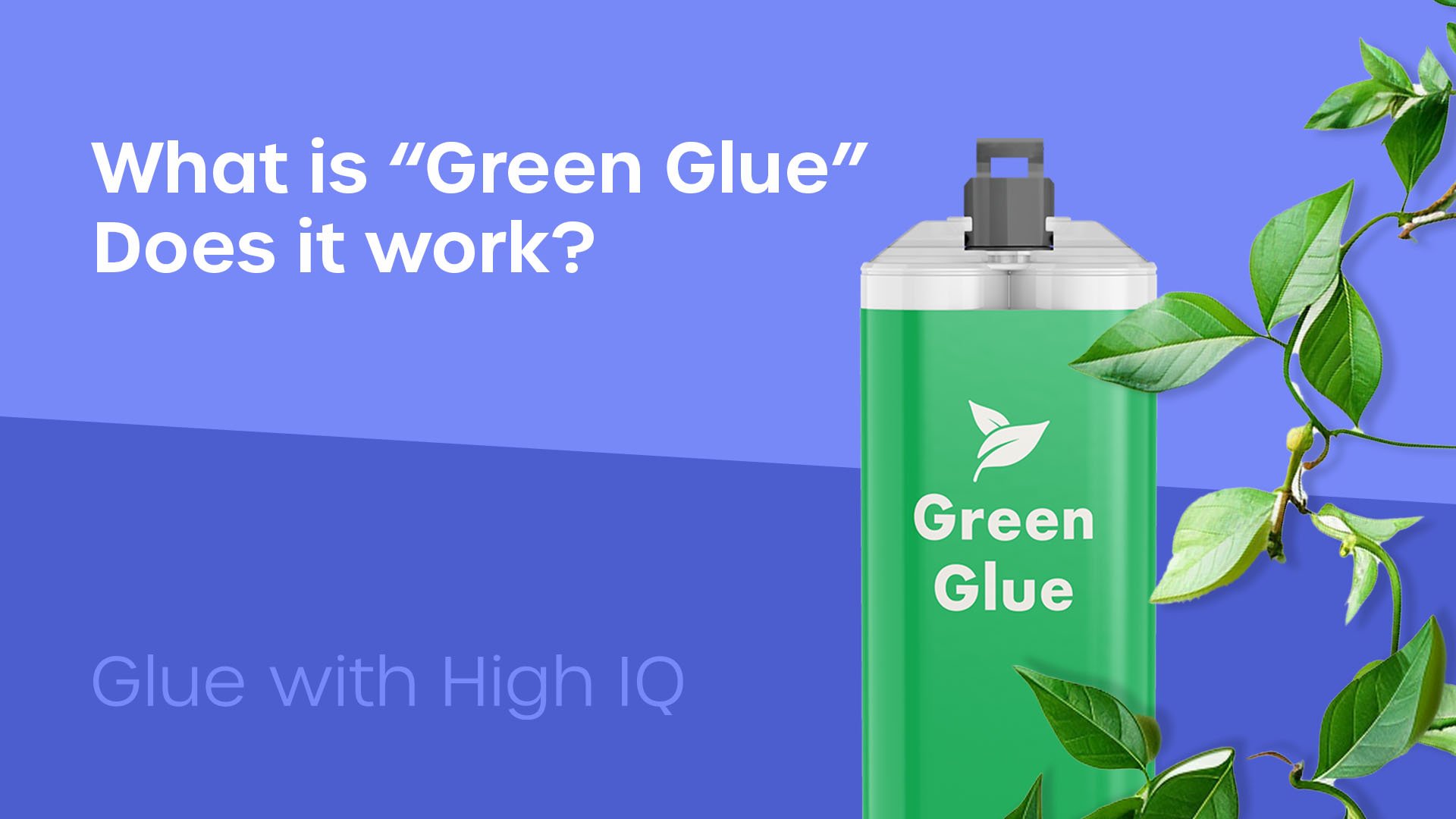The Paradox of ‘Sustainable Green Glue’: What is it and can it really improve sustainability?

As the fight against climate change heats up, companies are becoming increasingly conscious of their environmental impact. It’s no longer acceptable to do nothing. There are targets to meet.
Here at Forgeway, we manufacture industrial adhesives. Just like our customers, we are actively looking at ways to reduce our environmental impact. This article isn’t about us though. We want to discuss the most common question our customers ask us on this topic.
“Do you have a Sustainable Green Glue? We’d be very interested to see what options you have available.”
But it’s not simple to answer. The term ‘Sustainable Green Glue’ is very vague. The answer could vary depending on what the customer really wants.
This article will discuss what you might mean by ‘Sustainable Green Glue’. It will then make you aware of the drawbacks associated with these types of adhesives. They often can hinder you from achieving sustainability targets.
By the end of the article, you will know what to look for when searching for a ‘green glue’.
What is a sustainable green glue?
When companies are looking for a green glue, it’s likely adhesive manufacturers can market something as ‘green’ when it actually isn’t very sustainable.
When customers ask us for sustainable green glues, we like to understand what really mean. A request for ‘green adhesive solutions’ could mean something different for each company. There are often four main options that could indicate what a customer wants:
- An adhesive from renewable sources
- A recyclable adhesive
- An adhesive with a minimal carbon footprint
- An adhesive that has low toxicity
We’ll discuss each option to help you understand what each of these means. Maybe one of these options is what you mean by sustainable green glue.
Can renewable raw materials make a glue sustainable?
There is an increasing emphasis on reducing carbon emissions and dependency on fossil fuels. Most adhesive types will contain raw ingredients that are not renewable.
That’s why adhesives derived from renewable sources, like plant-based or bio-based feedstocks, are gaining popularity. These adhesives minimize reliance on non-renewable sources and reduce carbon emissions during their production.
When customers ask us for a ‘Sustainable Green Glue’, they often mean an adhesive that has renewable raw materials. However, these renewable raw materials will often have significantly lower performance.
It’s important to evaluate how much performance you are willing to sacrifice in order to find a sustainable glue. You will struggle to find high-strength and durable adhesives that are made from sustainable raw materials.
Nonetheless, with advancements in technology and research, adhesives manufactured from renewable materials are likely to become significantly better.

Does a glue have to be recyclable to be sustainable?
These are adhesives specifically formulated to either be recycled themselves or not impede the recycling process of the materials they bind.
Traditionally, industrial adhesives don’t come apart once applied. It’s what they are designed to do. Nonetheless, in the quest to create a circular economy, every material’s recyclability is paramount.
Adhesives that align with this vision ensure products aren’t prematurely destined for landfills because they’re challenging to recycle. They help create a more sustainable future. We would say a recyclable adhesive is sustainable and ‘green’.
Although once again, performance is an issue. Achieving recyclability without compromising adhesive strength and durability can be a balancing act. Adhesives are designed to create a permanent bond. It’s what they do.
So creating an adhesive that intentionally comes apart under certain conditions will always bring challenges.
Furthermore, recycling facilities must be equipped to handle and process these adhesives effectively.
In order to effectively create a recyclable adhesive, adhesive manufacturers need to formulate a product that will only deteriorate under very specific conditions.
The use of unique but affordable chemicals is perhaps the best route to explore. As demand increases for these types of adhesives, expect to see more recyclable adhesives on the market.
Currently, you will struggle to find a recyclable adhesive that can match the performance of structural and semi-structural adhesives available.

Is a glue with a low carbon footprint green and sustainable?
As with everything, adhesives have a carbon footprint. Due to the amount of raw materials in some adhesives, that carbon footprint can be significant.
Adhesives that, through their entire lifecycle, emit fewer carbon emissions compared to their traditional counterparts would still classify as sustainable in our opinion. Whilst they don’t meet the criteria of the green glues, they still play a role in reducing environmental impact.
Every step, from raw material extraction to production, transportation, application, and disposal, contributes to an adhesive’s carbon footprint. Lowering this can considerably reduce its environmental impact.
Sometimes, the steps to lower carbon footprint, like sourcing materials from remote eco-friendly companies or using energy-intensive green production methods, can paradoxically increase emissions elsewhere.
These adhesives are often significantly more expensive too. The raw materials that have a smaller carbon footprint are more costly, driving up the price of the adhesive.
Nonetheless, using ingredients that have a smaller carbon footprint doesn’t affect the performance of the adhesive. We’d say that these types of adhesives are a viable option for companies looking to use sustainable glue.

Does reduced toxicity mean a green and sustainable glue?
Toxic chemicals and volatile organic compounds (VOCs) are common ingredients in industrial adhesives. Sometimes, companies are looking for a low toxicity/VOC adhesive when they want a ‘sustainable green glue’.
Reduced toxicity not only diminishes environmental pollution but also ensures better health and safety for workers and end-users. It also reduces the risk of regulatory penalties and promotes a healthier brand image.
Recently, polyurethane adhesives have started to see restrictions come into use about how to safely use them. It’s likely other harmful adhesive types will face restrictions.
Similar to finding a low carbon footprint adhesive, low toxicity adhesives are a viable option. You’ll likely find low-toxicity adhesives that can replace more toxic options without a diminution of performance.
Nonetheless, transitioning to new formulations might require retraining and adjustments in application processes. Lower-toxicity adhesives may cost more too.
As there are already low-toxicity adhesive formulations available, we’d say this option is the most viable. And as research and development increase, these options are only going to get better.
If you’re looking for low-toxicity adhesives, make sure to explore Hybrid Polymer (MS) adhesives. They are one of the least toxic adhesive options available.

Will a sustainable green glue actually help you reach sustainability targets?
There’s an increasing display of ‘green adhesive solutions’. Adhesive manufacturers are showcasing their latest ‘innovatively sustainable adhesive’. But as is often the case, what shines in the lab doesn’t always glitter in the field.
While sustainability is a necessary pursuit, we need to take a holistic approach. As you will have read, a lot of the eco-friendly options have poorer performance than their non-sustainable counterparts.
This often raises the question. Should you sacrifice quality for the sake of the environment?
If it were up to us, we think companies should take a holistic view of the sustainable adhesive phrase. Yes, it’s produced from renewable resources or carries a low-toxicity badge.
But what happens when it’s exposed to real-world conditions? Does it stand the test of time, or does it buckle under pressure, leading to frequent repairs and replacements?
Such additional work escalates resource consumption, waste production, and overall environmental footprint. It’s ironic; in trying to minimize our carbon footprint, we might inadvertently be leaving deeper imprints.
While championing the cause of sustainability, let’s ensure our choices don’t inadvertently jeopardize the very environment we aim to protect. After all, true sustainability is about fostering harmony. Not just in the initial choice of materials but across the complete lifecycle of products.
We must have the bigger picture in mind. Are you really helping the green movement? Will a so-called ‘sustainable adhesive’ help the fight against climate change? Or is it a tick-box exercise?
Unfortunately, this is often the case.
We would always say that high-performance adhesives will have a far greater impact on the sustainability movement than eco-friendly alternatives.
Yes, there are things you can do. Purchasing products with a lower carbon footprint and reduced toxicity will provide much more than environmental benefits. They’ll also usually not impact performance either.
When it comes to using a sustainable adhesive, we strongly advise putting performance ahead of eco-friendliness. It will be much more beneficial for the environment in the long term.

Knowing what to look for when choosing a green sustainable glue
You know the different types of glues that could qualify as ‘sustainable’. You also know that you shouldn’t sacrifice performance when looking for sustainable green glue.
So what should you do? We often receive this question from industrial manufacturers. As adhesive manufacturers, we produce a range of different adhesives.
When companies ask us this question, we explain why performance shouldn’t be sacrificed. Then we analyse the application to recommend an adhesive that will meet the requirements.
Nonetheless, if you’re looking for an adhesive that has a reduced carbon footprint, it’s not all that simple. Adhesive manufacturers aren’t always transparent about the carbon footprint of their adhesives. It can be difficult to tell the true carbon footprint of the adhesive.
Here at Forgeway, we always aim to purchase local raw ingredients where possible. The carbon footprint is significantly lower than raw ingredients imported from China or other suppliers. It’s part of our ‘Greener Durability’ mission.
If you’re looking for low-toxicity adhesives, we advise taking a look at Hybrid polymer (MS) adhesives. There are some very high-performance MS polymer adhesives available. They also are completely non-toxic.
When it comes to adhesives that have renewable ingredients or are recyclable, we strongly advise analysing the performance requirements before choosing an exo-friendly adhesive option.
Read the article below which explains what to consider before choosing an adhesive. It will help you understand how to get the right adhesive for your application. Then you can analyse sustainable and green solutions.
But remember, don’t let sustainability cloud your judgement. A higher-performance adhesive with fewer ‘green’ credentials is going to have a greater environmental impact than a product marketed as ‘green and sustainable’.
Thomas is the Content Manager here at Forgeway. Thomas' job is to translate the technical jargon from the ivory tower of academia into easy-to-read content that everyone can understand. Forgeway's mission is to answer every question our customers and prospective clients ask, or are apprehensive to ask.



